Vancouver Viaduct History and Future
Last month Vancouver City Council decided to proceed with a second series of studies that would concern the future of the Georgia and Dunsmuir viaducts [The Province]. The current viaducts, installed in 1972, serve as passage for tens of thousands of vehicles (and bikes) into the downtown core from False Creek, Chinatown, and East Vancouver. The City’s vision is to modernize transportation and traffic flow, but they’re just not sure how to go about doing so just yet.
Vancouver’s actually had viaducts in place, in that area, for close to 100 years so I thought it may be worth looking at their history to see where we might go in the future.

1913 – Georgia viaduct under construction. Imagine Rogers Arena to the right, BC Place to the left.
Vancouver Archives item# CVA 99-1303. Photographer: Stuart Thomson
On July 1st, 1915, the first Georgia viaduct opened for streetcar use. It extended over the CPR’s Beatty Street yard and it was named the “Hart McHarg” bridge after a World War I hero. Apparently the viaduct was so poorly constructed that within a few years of it going up, chunks began to fall on, endangering pedestrians below.

1915 – Georgia Harris Street viaduct opening. Vancouver Archives item# PAN N100B. Photographer: W.J. Moore

1915 – Car on the Georgia Viaduct, Sun Tower in the background. Archives# CVA 99-18.
It wasn’t until 1963 that, under the leadership of Bill Rathie (the first mayor of Vancouver that was actually born in the city), a 20-year program was drawn up that would involve redevelopment, transportation solutions, low-cost housing, and a downtown revitalization. A new Georgia viaduct was thought up for cars to allow easier access to downtown.
But the replacement viaduct in the 1960’s and into the 1970’s was also part of a larger plan. There was a movement to build a freeway system right into and through downtown Vancouver. Can you imagine Highway 1 ploughing right through East Vancouver, Strathcona, and Chinatown? This was the grand idea and it was thought that the viaducts would nicely connect the freeway to the city’s centre.

Between 1971 & 1981 – Georgia and Dunsmuir viaducts from the air. Vancouver Archives item# CVA 780-8.
Before the freeway plans were solid, buildings were being razed in anticipation. This included the Hogan’s Alley community, which was bulldozed to make room for the new Dunsmuir and Georgia viaducts. Buildings on the East side were reduced to rubble and wiped off the city map — and this is where residents stepped in. Strathcona community activists created much opposition to the grand plan and ended up saving their corner of the city.
Now, forty years later, the issue has been raised again. So far I’ve heard both opposition and support for getting rid of the Dunsmuir and Georgia overpasses. For example, during the Vancouver 2010 Winter Olympics the viaducts were closed to public traffic. Some felt it was a blessing while others found it terribly inconvenient and had to find alternate routes to get around.
From The Tyee: “The demolition and removal of the Georgia and Dunsmuir viaducts could begin in as little as five years, opening a wide swath of virgin land to public space and development — and forming the eastern core of Vancouver’s new 21st-century downtown.”
“Bev Davies, a punk rock photographer who fought against the original freeway (in particular, the plan to bore a tunnel beneath Burrard Inlet) wants the viaducts gone because more than 40,000 cars pass her front door every day at Princess and Prior streets.”
From Councillor Geoff Meegs: “For the next year residents will be invited to put their ideas forward in an “ideas fair” and international and local experts will make their own recommendations. The project also opens the door to planning of the False Creek Flats, the last major area slated for development in the city core.”
From The Georgia Straight: “Public consultation over the coming months will come in the form of an “ideas fair”, an expert panel of local and international experts, and a series of public discussions and consultations.”
At this point, residents and concerned citizens will be able to voice their opinions at these “ideas fairs” and learn more about proposed plans over the course of the latest year-long study.
[poll id=”64″]
Please note that reference material was found thanks to the research of the late, great, historian Chuck Davis.

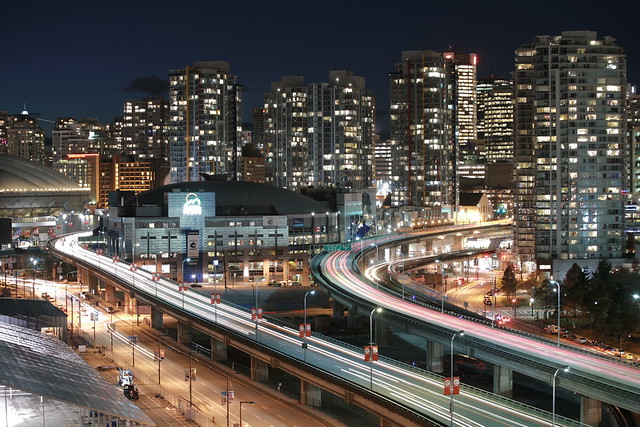
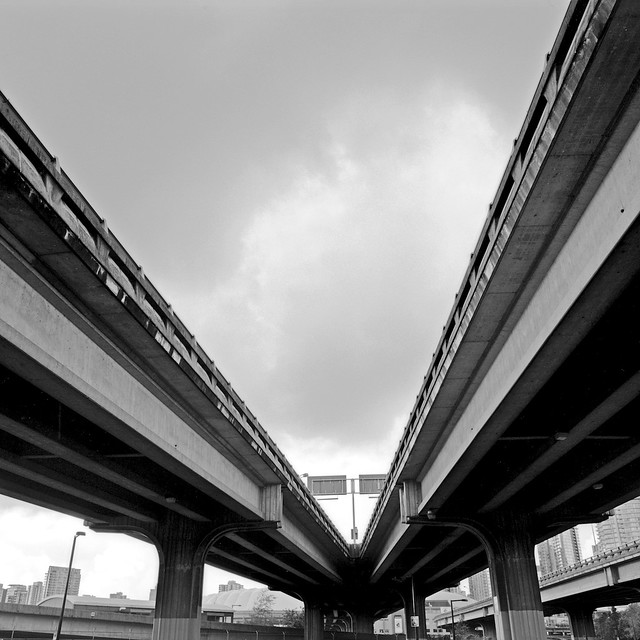

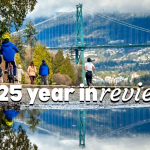

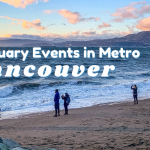

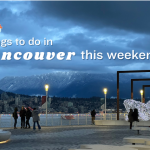
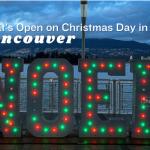
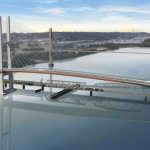


14 Comments — Comments Are Closed
I live within one block of the viaducts and should be one of the people most in favour of their demolition. They inhale some of the worst traffic in and out of the city, as well as scream the noises of industry that people despise. They are a bit of an eye-sore and may be the only part of Vancouver’s core that resembles many of the high-density metropolitan centres that 604 residents run from.
The reality to me however is that as much as they are all this, the bike lanes are making them a much more positive throughway and the Olympics proved that if there is a focus on increased public awareness of car-sharing, transit, and flexible work environments, traffic can be reduced. But beyond all this, this city is not ready yet to lose that expressway to East Van, traffic via Gastown and Yaletown is coming to a screeching halt now that densities increase, a potential casino could slam the area with more traffic, re-opening of BC Place will add more traffic, and as a positive, bikers find these lanes extremely useful. As someone living next to these lanes, I do not think demolishing them should be considered for a couple of decades until more people are weened off cars and onto car-share and transit. Forcing people only adds to the perception of governments intent on undermining business (low office space), entertainment (hst/parking rates), and controlling lifestyle (bike lanes, left-turn limitations).
The only winner in any of these discussions would be Concord Pacific. Removing the viaducts would greatly improve the value and quality of experience for their soon to be built condos along the north shore of False Creek. Please do not give in to their demands to turn cross-town/chinatown south into another yaletown. The area around the viaducts is a clear area of civic engagement that is not available anywhere in the city core right now. With many areas available for large city events (dragon boat fest, flugtag), sporting meets (street basketball/hockey), skate park & events.
when and where will these “ideas fares” be held?
I don’t believe the dates have been set yet. I’ll update this post when they are.
The areas beneath the viaducts are, for the most part, barren tracts of land, undeveloped or poorly developed.
One gets the impression that these empty parcels of land could have been used for the extra traffic the viaducts were meant to accommodate.
Get rid of them, and replace with….. what?
If the idea is, to just scrap them, then no.
If the idea is, scrap them and replace them with super-bike lanes, organic chicken farms, and promises of social housing (that don’t actually get built), then no.
If the idea is to replace them, reroute the traffic, and bolster the new traffic arteries to support the increased load. Then re-designate the land for mixed development, then yes.
Vancouver is one city (not sure how many are similar) that does not have some sorta Freeway/highway running through it or close to it.
I miss the plans when there was supposed to be a tunnel from Burrard Bridge to Coal Harbour over Brockton Point to North Vancouver. But then that didnt happen.
To get rid of the viaduct, what does that solve exactly?
Now, I know Vancouver would LOVE to get rid of all vehicle traffic to the downtown core, removing this route would just push traffic in other places right?
The land that is to come from removing the viaduct, what type of zoning will go in? Will it be high-priced res/com? or support lower-incomes? Will it be more green-space?
Oh.. I would support the #1 going straight through the downtown core of Vancouver and over to the North Shore 😉 Swing the #1 down 12th or something, then pop it over False Creek 😛
“Bev Davies, a punk rock photographer who fought against the original freeway (in particular, the plan to bore a tunnel beneath Burrard Inlet) wants the viaducts gone because more than 40,000 cars pass her front door every day at Princess and Prior streets.”
Getting rid of the Viaducts won’t stop these 40’000 cars going into downtown. They’ll just go past someone else’s front door or maybe still past Bev’s but 30 ft lower down.
I totally agree with James’ comment that the space underneath is under-utilized but otherwise these provide a fast and convenient way to get people in and out of the busy downtown area.
Keep the viaducts…. Vancouver has poor traffic in and out of the downtown core as it is. Removing the viaducts will only make the traffic problem worse leading to slow moving traffic with cars idling at stop lights and trying to manouver around getting out of (and into) the downtown core. Just because the viaducts are there doesnt mean the land around them needs to be poorly developed…. I am sure Concord Pacific will put the investment into another beautiful neighbourhood just like they have done with Yaletown- with the viaducts in place.
I would agree with removing the viaducts. Both as a driver and a cyclist I find them incredibly useful, no doubt. But they are undeniably hazardous to the surrounding area (unsafe and crime-ridden underneath, bad land-use), are no longer meeting traffic density demands, and ugly to boot. I would suspect they are the root of a lot of other traffic inefficiency downtown as well.
I take as evidence the fact that they are 100 years old. Based on that alone, there is no way these viaducts are the most efficient solution today and I am sure significantly better options have been and will be proposed.
These viaducts have had a good run and served Vancouver well but it is time we stop designing the city around these viaducts and, instead, re-design a traffic solution around what we want the city to be.
P.S. In the spirit of full disclosure I admit that I am usually more in favour of solutions that “encourage” people to change their habits (such as not driving to work) than waiting for them to change themselves because without motivation they never will.
Isn’t Vancouver broke right now? Why would they even consider a huge project like this right now? Are they near end-of-life soon and actually NEED to be taken down/replaced/upgraded?
First and foremost, they need to plan for where the traffic is going to go and plan ahead for a higher population density. If there isn’t an adequate plan for these, then forget it. I just think it’s poor planning to assume that people will behave in a certain way to adapt to the new infrastructure. Whether it’s a better road system or some kind of new fast and efficient public transit link to the east side, I’d like to see something concrete. That said, I think we could do something creative like “high line” in New York. Tear down the Georgia viaduct but keep the Dunsmuir viaduct for bike access and transform it into a beautiful raised park that links chinatown and downtown. I really enjoy having the view of the city, False Creek and the mountains when I bike to or from the city.
Minor point Rebecca, as far as I know (that is, from what I’ve read from various sources), the old Georgia Viaduct never actually had streetcars, despite the tracks… As you noted, too poorly constructed, could not handle the weight… they even removed every other lamppost to reduce the weight. If you look closely, you can see tracks in the stub of Georgia Street west of Main where the old viaduct used to end.
The photo you linked to of construction in 1913, compared to its demolition in 1971 http://farm3.static.flickr.com/2589/4038505585_08e67331cd_b.jpg
One big issue here is the poor management of traffic in Vancouver (I will provide examples later), and removal of the Viaducts will be another big mistake causing huge delays getting into and out of downtown. Very few people actually have traffic engineering knowledge (formal/informal); nor are they interested in the topic. After asking many friends in Vancouver who have taken a trip abroad for example Britain and Hong Kong about the road design there and here; they were unable to compare and contrast.
In any regard, the viaducts need to be kept as the City’s road and transportation infrastructure -as I said before- is far from being optimal. A large portion of the complaints arise from the Strathcona Area is due to the massive amount of vehicle traffic moving past their homes each day. The ducts should be re-aligned so that it passes through the rail yard a bit to the south and extended to meet up with Clark Street.
Removing them will only cause trucks and large vehicles to re-route to other already congested city streets. If we keep the and re-align ducts, I am sure we can keep large trucks on that route by designating that as a truck-route and enforcing it, this in turn will benefit everyone who is interested in traffic calming in their community.
Also with the ducts gone, it will also be evident that new streets will have to be built and/or re-aligned causing the installation of more delay and pollution inducing traffic lights. There are business owners that want to relocate after their lease is up, and others not wanting to bring their business into downtown.
In Vancouver, it seems as if traffic lights are the solution to every problem, yet they want to be the greenest city on earth. Having more lights will cause more idling. Think about the massive amount of pollution generated during, the many hours’ worth of idling as hundreds to thousands of cars stop at each traffic signal every day! I know that leaving your engine running can lead you to a fine, encouraging drivers will turn off their ignition when waiting, but that amount of idling is effortlessly dwarfed by that caused by traffic lights. The city is here contradicting themselves by not co-relating and looking at the big picture. It’s also the reason why we get less miles per gallon within the city.
Here are some solutions that residents and staff with the City of Vancouver should think about to help solve the transportation issues as a whole:
1. Many intersections are currently large enough and satisfy the requirements to build a roundabout with 1-3 lanes; and they provide all the “green” and safety most Vancouverites want!
1) No need for electricity – this means no 4-Way stop delays during power interruption
2) Traffic is slowed and increases safety
3) Traffic enters at an angle reducing T-Bones and injury
4) Opportunity for landscaping the center island.
5) Less delays / stopping = less pollution
One argument when I talked with CoV Engineering is large vehicles requiring a large turn-radius: this could be mitigated with a mini-roundabout which is just a dab of white paint in the middle of the intersection.
Another is for bikes – you could either ride through or use the sidewalks. I would rather be struck by a car moving slowly through the roundabout than get T-Boned at high speeds in a conventional signalized intersection. In fact, in Hong Kong and perhaps else ware also, there are even roundabouts built specifically for bikes!
There is a mass amount of information and research reports out on the internet for those who want to research this topic further. One company, Ourston Roundabouts have worked on projects in both the US and Canada.
2. Safety can also be improved without lowering the speed limit by constructing a taller central reservation instead of the curb-high medians we see today. They provide some landscaping but do very little in the prevention of a head-on collision. In speeds as low as 30-40km/h, a vehicle can easily go over onto oncoming traffic.
Not only that but also the city has the habit of not repainting the yellow line after that low-height median has been built, reducing visibility in poor weather conditions).
The higher median could be complemented with a fence or a tall planter box along the side of the curb with tall trees. This will prevent or highly discourage jay-walking, and once the trees are fully grown they provide shade and also make it feel like the busy street isn’t there at all or not bothersome any more.
On street parking also do not need to be sacrificed – there could be a pocket lane with a high planter barrier separating the traffic lanes. An example would be next to the Telus building on Boundary Rd; or the small strip mall complex on Victoria and 54th Avenue.
3. To save land use, buildings and other structures can be integrated with the ducts, and at grade level roads can be re-aligned under the ducts, which is what many large cities in Asia are doing.
The number of traffic lights and congestion in Vancouver is just unimaginable. If only enough people recognize alternatives such as roundabouts and means of preventing jay-walking as I mentioned above to increase safety, and reducing delay, while keeping the city green.
With growing population, the city should look at ways to improve infrastructure not degrade them. This also goes for public transit. The new Canada Line, built with only 2-Cars which is even longer than the platform itself, compared with the MUCH older Expo Line when there were not as many people around. Those trains are already over-crowded during peak hours. Perhaps having deploying a 8-Car mass transit system should have been more appropriate.
I chose Hong Kong (British Design) as a reference since I studied and scrutinized their designs very closely. A drive across town would never involve stopping so many times at signals compared to here. Vancouver and HK are both growing and expanding rapidly. For if Hong Kong’s road infrastructure was built exactly the same way as here, it would potentially mean no one will be able to get anywhere. If you want to take a look at the infrastructure design there, Google Streetview is available.
My point here is, we need to think out of the box and adapt new design concepts to reduce delay, increase safety, livability and reduce pollution, without tearing down the viaducts which would seem to me as a step back rather than a step forward, while at other places in the world they are building infrastructure while we want to tear them down.
In any case, this city has a lot to improve on with their road and transportation network that should be done before even thinking of removing the viaducts, which they should not be doing.
According to the City, there are 40,000 vehicles per day using that part of never completed freeway in and out of the city. In the seventies the public pressure stopped the freeway we would have loved to use today. With density in downtown core on an constant increase how does the City planners envision the future traffic flow is a subject no one wants to address.
So far all we have done is diverted 40,000 vehicles in to the city streets’ stop and go traffic, increased air and noise pollution for the very residents who had their way some 45 years ago.
Viaduct was originally build in early years of the last century, for obvious reasons and we mostly had horse and buggies traffic then. Obviously past generations saw the need to get in and out of the city fast and easy, just like today’s generation.
Should we ever have a disaster likes of 911 in Vancouver, (and we have now enough enemies) I wonder how we would evacuate downtown core and who would we blame for countless casualties unable to flee the place.